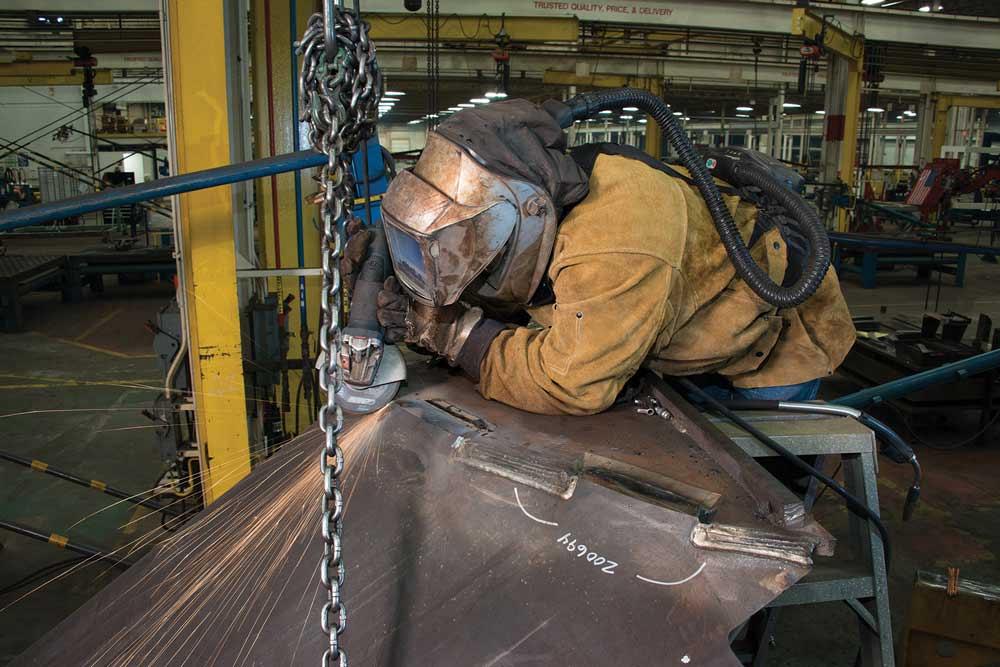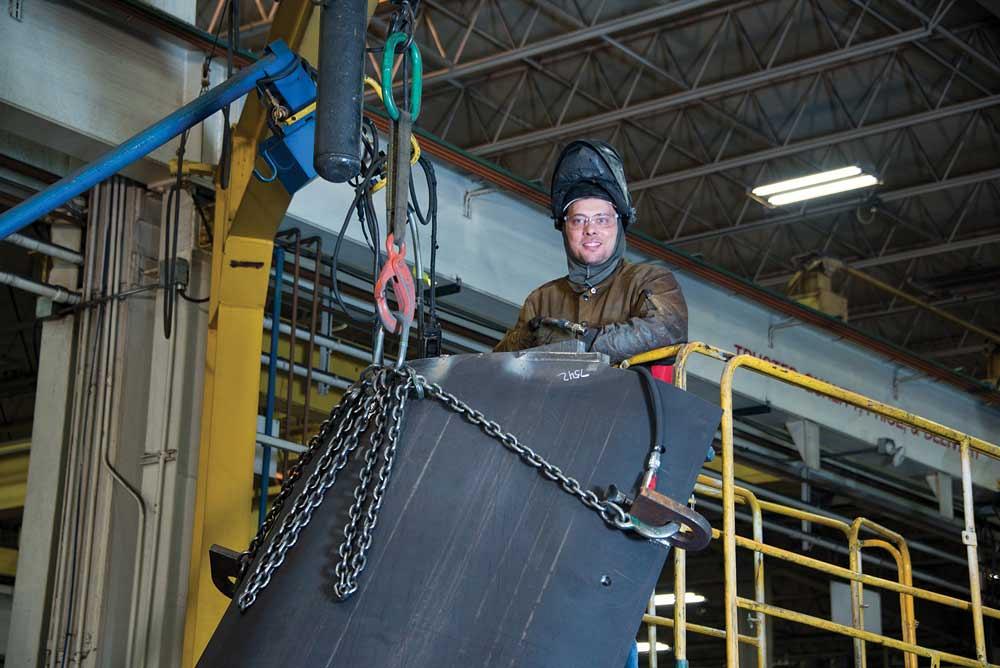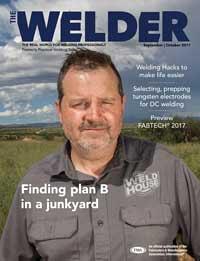Editor-in-Chief
- FMA
- The Fabricator
- FABTECH
- Canadian Metalworking
Categories
- Additive Manufacturing
- Aluminum Welding
- Arc Welding
- Assembly and Joining
- Automation and Robotics
- Bending and Forming
- Consumables
- Cutting and Weld Prep
- Electric Vehicles
- En Español
- Finishing
- Hydroforming
- Laser Cutting
- Laser Welding
- Machining
- Manufacturing Software
- Materials Handling
- Metals/Materials
- Oxyfuel Cutting
- Plasma Cutting
- Power Tools
- Punching and Other Holemaking
- Roll Forming
- Safety
- Sawing
- Shearing
- Shop Management
- Testing and Measuring
- Tube and Pipe Fabrication
- Tube and Pipe Production
- Waterjet Cutting
Industry Directory
Webcasts
Podcasts
FAB 40
Advertise
Subscribe
Account Login
Search
Fabricating a safe manufacturing environment
Merrill Fabricators takes steps to protect employees as they work with very large weldments

Merrill Fabricators doesn’t have to worry about grinding down large castings, but welders like Ben Hogan are involved in some activities, such as blending in welds and backgouging. That’s why the company has welders wear hoods with a grinding shield underneath a flip-up autodarkening lens. The hoods also have air feeds that help to battle condensation on the interior of the shield and to keep the welders comfortable.
A shop that works with a lot of heavy fabrications is no place for the head-in-the-clouds crowd. The shop floor employees need to be focused on the fabricating task at hand and aware of their surroundings. If they aren’t, they run a great risk of getting hurt.
Merrill Fabricators, Alma, Mich., has worked hard to improve its work environment over the past several years so that its workers can do what they do best—fabricate large weldments. (Merrill Fabricators is a business unit of Merrill Technologies Group located in Saginaw, Mich.)
“Our employees are our No. 1 resource and our most valued asset, so we want to be sure they are healthy day to day,” said Brian Engelhardt, the plant manager.
This makes sense from not just a moral perspective, but also a business viewpoint. For example, Merrill Fabricators employs just over 70 welders, a majority of whom are highly skilled and AWS/ASME-certified with mastery of multiple welding processes. Without them, the company couldn’t produce the fabrications it has been charged with delivering to customers.
Another business factor to consider is that a safe workplace saves a company money. A little less than 10 years ago, Engelhardt said that Merrill Fabricators’ workers’ compensation premiums were rising. The company was close to seeing its experience modification rate increase, and it needed to make a change to stem the expense. (A “mod” factor, which is partly determined by industry classification and a company’s recent history with recordable injuries, is used to determine how much a business pays in workers’ compensation premiums.) As a result, Merrill Fabricators hired a full-time safety professional.
Since then the fabricating operation has turned around its safety performance. In 2016 it had only one reported lost-time injury. Safety is first and foremost in almost everything the company does.
When the company hires someone, the individual—no matter how much experience he or she might have at a prior job—goes through a full safety program even before they set foot on the shop floor, according to Jesse Willoughby, Merrill Fabricators’ safety coordinator. Students who attend the Merrill Institute, a welding and fabricating skills training program housed in the Alma facility, also have a heavy focus on safety and health, spending a whole day learning about personal protective equipment, the types of injuries that can occur and how to treat them, and potential hazards on the shop floor.
“We can work a lot of hours here, so if you have a team member that is out with an injury, that can really hurt productivity,” said Jason North, Merrill Institute’s manager of operations and training. “We want to keep everyone healthy and productive.”
The team leaders, however, are the eyes on the front line of the safety battle. They assign the work, and they ensure that proper safety procedures are followed as the work is done over a shift. Additionally, Willoughby regularly walks the shop floor, keeping an eye out for unsafe work practices and anything that might be deemed too risky.
Safety is also at the heart of several regularly occurring events. For instance, Engelhardt, Willoughby, and Jeff North, the company’s manufacturing manager, engage in a safety walk every week, during which they make observations, discuss possible changes, and entertain suggestions from the shop floor employees. Willoughby holds monthly meetings with the welders to address safety issues that may have come to the surface over the previous 30 days. Layered process audits are conducted each month, and anything that may be identified as a safety risk is noted; those findings ultimately lead to corrective action designed to protect workers’ health. On top of all that, a quarterly audit, based on OSHA standards, is conducted, and the workers are held accountable for simple actions, such as always wearing safety glasses and tying off when in a lift, that should be habits for them by now.
“It’s been a real culture change for us,” Engelhardt said. “We now have individuals that do look out for their peers all the time. So if they see a co-worker doing something that’s unsafe, they will speak up.”
About the Author

Dan Davis
2135 Point Blvd.
Elgin, IL 60123
815-227-8281
Dan Davis is editor-in-chief of The Fabricator, the industry's most widely circulated metal fabricating magazine, and its sister publications, The Tube & Pipe Journal and The Welder. He has been with the publications since April 2002.
About the Publication
subscribe now

The Welder, formerly known as Practical Welding Today, is a showcase of the real people who make the products we use and work with every day. This magazine has served the welding community in North America well for more than 20 years.
start your free subscription- Stay connected from anywhere

Easily access valuable industry resources now with full access to the digital edition of The Fabricator.

Easily access valuable industry resources now with full access to the digital edition of The Welder.

Easily access valuable industry resources now with full access to the digital edition of The Tube and Pipe Journal.
- Podcasting
- Podcast:
- The Fabricator Podcast
- Published:
- 04/16/2024
- Running Time:
- 63:29
In this episode of The Fabricator Podcast, Caleb Chamberlain, co-founder and CEO of OSH Cut, discusses his company’s...
- Industry Events
16th Annual Safety Conference
- April 30 - May 1, 2024
- Elgin,
Pipe and Tube Conference
- May 21 - 22, 2024
- Omaha, NE
World-Class Roll Forming Workshop
- June 5 - 6, 2024
- Louisville, KY
Advanced Laser Application Workshop
- June 25 - 27, 2024
- Novi, MI
































